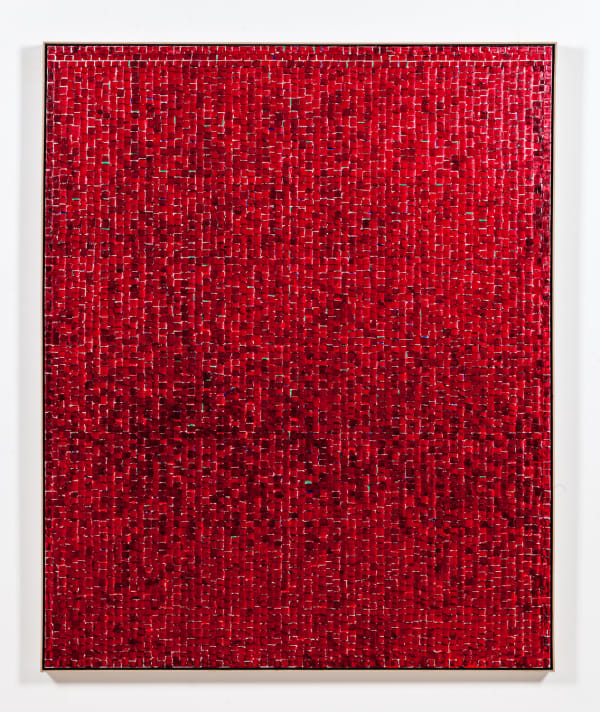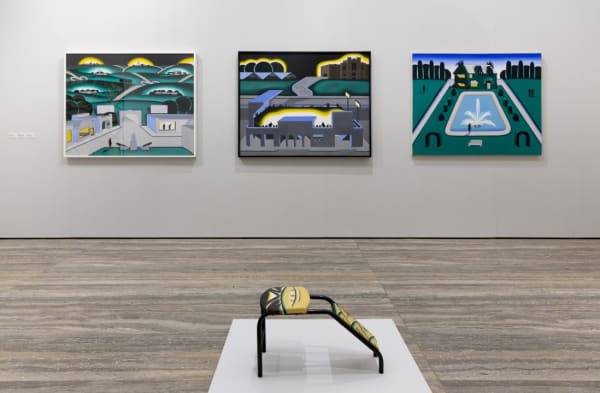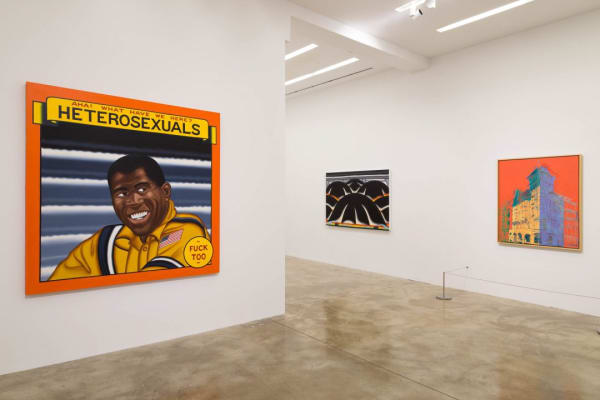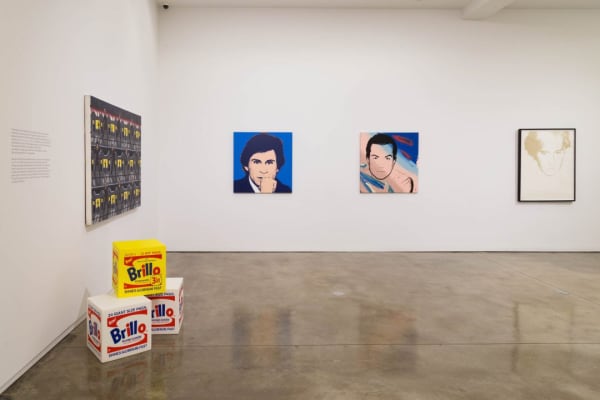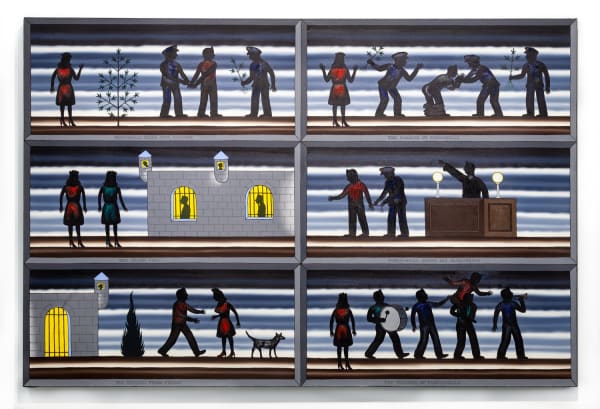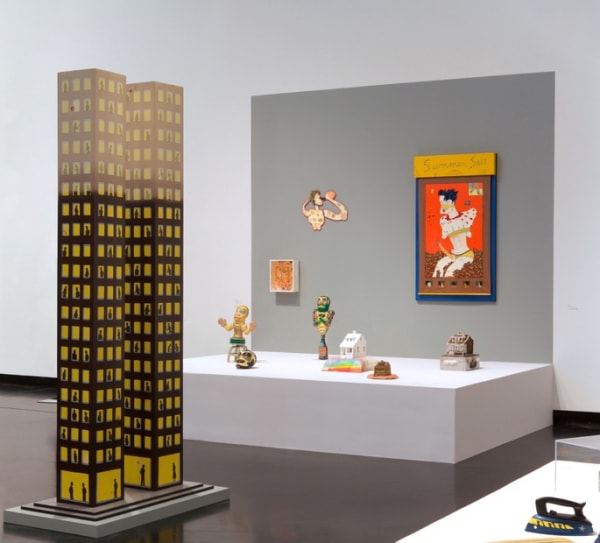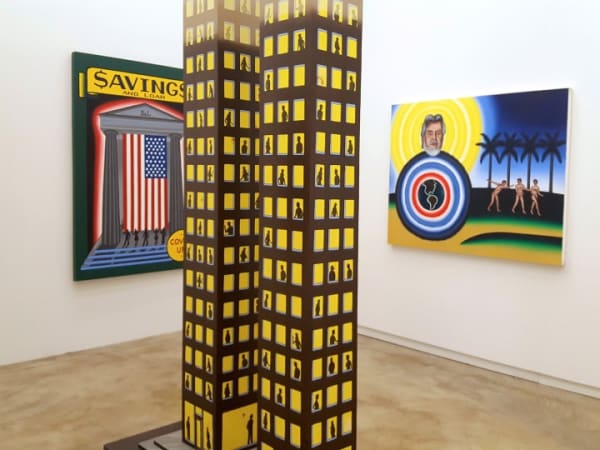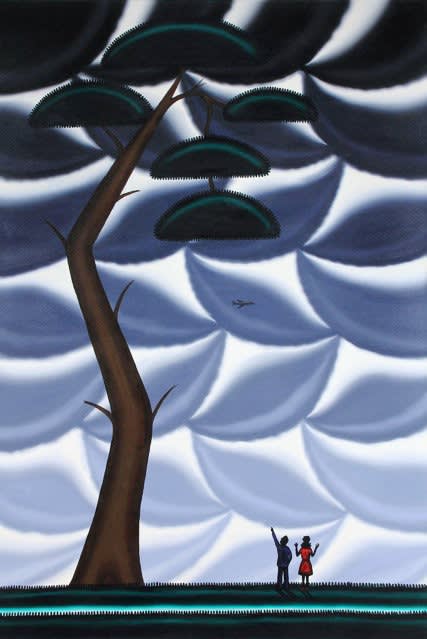Estate of Roger Brown American, Alabama, 1941-1997
Roger Brown is renowned for using a pop aesthetic to investigate a range of sociopolitical issues. Late-capitalist critic, 20th century Shakespeare, Pictorial Prophet of the Prairie: Brown summarized, glamorized, and satirized the nightly preoccupations and daily desires that define what it means to be an American.
Brown’s work is of startling contemporary relevance, cleverly approaching many topics: the natural and built environment, disaster, religion, popular culture, the art world, art history, eroticism, and sociopolitical concerns, from modern warfare to mortality during the HIV/AIDS crisis. In a world ever more dominated and challenged by the American myths that Brown so dutifully and brilliantly addressed in his work, we are called now more than ever to look to the humor, beauty, and intelligence of this artist who worked beyond the boundaries of his own time.
More succinctly than any other artist of his generation, Brown captured both the tenderness and the hubris of his home nation, even as that same nation seemed unwilling to create a safe space for him to be truly free.
As a gay man born in the Deep South, Brown had a crystal clear understanding of otherism, and of the insidious reach of American puritanism and political hypocrisy. When he was diagnosed as HIV positive in 1988, he joined the tens of millions of other victims of humanity’s other ongoing pandemic who even now are often a target for scorn and shame.
Yet, while informed brilliantly by his personal history and identity, Brown’s oeuvre was anything but one sided. His work took on every topic of conceivable interest to the socially conscious public of his time. His imagist interests spanned from Broadway to the Midwestern cornfields; from ancient architecture to future wars; from the mean streets of Hollywood to the winding roads of remote villages.
Ironically, even Brown’s idiosyncratic artistic position set him up for criticism. Rooted in classical figuration and illustration, his paintings suggest a fairytale aesthetic—a clear visual outlier during a time when the art field was dominated by conceptualism, experientialism, and suspicion of the artist-made object.
Despite Brown’s outsider status, he grew to be regarded by many as a modern master before his death in 1997 from complications related to AIDS. He possessed the highest credentials, earning both his BFA and MFA from the renowned School of the Art Institute of Chicago in the 1960s, partly under the tutelage of Ray Yoshida, as one of a generation who would later become known as the Hairy Who, or the Chicago Imagists.
The Roger Brown Study Collection, maintained by the School of the Art Institute of Chicago, makes Brown’s prolific art collection and archive available to the public. Brown’s paintings have recently been featured in group exhibitions at the Fondazione Prada, Milan, Italy, and MoMA PS1, New York, USA, and his Virtual Still Life works were highlighted in a solo exhibition at the Museum of Arts & Design, New York. The artist’s work is included in notable private and public collections including the Metropolitan Museum of Art, Museum of Modern Art, and Whitney Museum of American Art in New York; Art Institute of Chicago; Museum of Contemporary Art, Chicago; Los Angeles County Museum of Art (LACMA); Museum of Fine Arts, Boston, National Gallery of Art, and The National Portrait Gallery.
-

Matter of Fact: Material as a Political Act
KAVI GUPTA | WASHINGTON BLVD. FL. 2 25 Apr - 19 Jul 2025These artists explore the politics of materiality, how thread, clay, pigment, and gesture can serve as acts of reclamation, resistance, and cultural continuity.Read more -

Roger Brown: Palace of Wonders
KAVI GUPTA | WASHINGTON BLVD. FL. 2 1 Apr - 10 Jun 2023Kavi Gupta presents Roger Brown, Palace of Wonders , an exhibition celebrating Roger Brown’s late-career series of paintings based on the visual language of circus sideshow banners. Brown was an...Read more -

Roger Brown & Miesian Metropolitanism
Edith Farnsworth House, Plano, IL 7 Aug - 27 Nov 2022Roger Brown and Ludwig Mies van der Rohe stand as exemplars of their respective aesthetic positions—beacons of pure intention and masterful execution. This exhibition seeks to examine Brown’s particular “Miesian”...Read more -

Kavi Gupta Pop-Up Gallery: Palm Beach
TAKING PART OF THE ARTS & CONVERSATIONS SERIES 7 - 28 Dec 2021Presenting Kavi Gupta at Art & Conversation Palm Beach, with Regan Rohde December 7 – December 27, 2021 Register for appointments between 12pm - 5:30pm Info@Kavigupta.com, Text 312.399.0007 1608 S...Read more -

Private Eye: The Imagist Impulse In Chicago Art
Indianapolis Museum of Art | Indianapolis, IN 21 May - 5 Dec 2021In the mid-1960s, a cadre of adventurous young artists began exhibiting at the Hyde Park Art Center in Chicago. With myriad influences from Surrealism and non-Western art to comic books...Read more -

Roger Brown, HYPERFRAME
Kavi Gupta | 835 W. Washington Blvd., Chicago, IL 26 Mar - 27 Nov 2020Kavi Gupta presents Roger Brown: Hyperframe, an exhibition bringing together an unprecedented selection of multi-frame paintings by one of America’s greatest Imagists.Read more -

Theater Of Operations, The Gulf Wars 1991 – 2011
Moma PS1 | New York, NY 14 Nov 2019 - 1 Mar 2020Theater of Operations: The Gulf Wars 1991–2011 is a large-scale group exhibition that examines the legacies of these conflicts beginning with the Gulf War in 1991, featuring over 300 works by more than 80 artists based in Iraq and its diasporas, as well as those responding to the war from the West.Read more -

Roger Brown: Virtual Still Lifes
Museum of Arts and Design | New York, NY 2 May - 15 Sep 2019Roger Brown: Virtual Still Lifes brings together, for the first time, a vast grouping of the artist’s “Virtual Still Life” paintings (1995–97) made near the end of his career.Read more -

HOW CHICAGO! IMAGISTS 1960S & 70s
Goldsmiths CCA | St James’ New Cross London 15 Mar - 26 May 2019Artists: Roger Brown, Sarah Canright, Jim Falconer, Ed Flood, Art Green, Philip Hanson, Gladys Nilsson, Jim Nutt, Ed Paschke, Christina Ramberg, Suellen Rocca, Barbara Rossi, Karl Wirsum, Ray Yoshida.Read more -

Roger Brown, La Conchita
Kavi Gupta | 219 N. Elizabeth St. Chicago, IL, 60607 10 Nov 2018 - 12 Feb 2019Kavi Gupta is pleased to present Roger Brown: La Conchita. Opening November, 10 at the Kavi Gupta Elizabeth St. location, the exhibition will feature the contents of Roger Brown’s southern California home. Brown, seeking a new place to work in a warmer climate, built his Temple of Painting at La Conchita, California, commissioning Stanley Tigerman to design the new home.Read more -

Roger Brown, 3-D Doings: The Imagist Object in Chicago Art, 1964-1980
Tang Art Museum | Saratoga Springs, NY 8 Sep 2018 - 6 Jan 20193-D Doings: The Imagist Object in Chicago Art, 1964-1980 explores the sculptural work and dimensional paintings of a group of Chicago artists collectively known as the Chicago Imagists.Read more -

Roger Brown Estate, Famous Artists From Chicago 1965-1975
Fondazione Prada | Milan, Italy 27 Oct 2017 - 15 Jan 2018Fondazione Prada will present at its Milan venue a research and information program on the Chicago art scene developed in the aftermath of World War II.Read more -

Roger Brown Estate, Estate Paintings
Kavi Gupta | 219 N. Elizabeth St. Chicago, IL, 60607 5 May - 24 Jun 2017Read more -

Roger Brown and Andy Warhol, Politics, Rhetoric, Pop
Kavi Gupta | Elzabeth St 23 Sep - 22 Nov 2016Penning a list of pop artists including Roy Lichtenstein, Andy Warhol, and himself, Roger Brown writes in the 1980 Who Chicago? that “what is shared is attitude and not style.” Brown’s admiration for—and aesthetic affiliation with—Warhol’s work positions him far beyond the superfluity of purely regionalist designations.Read more
Roger Brown & Andy Warhol -

Gist & Gesture
Kavi Gupta | 835 W. Washington Blvd. Chicago, IL, 60607 4 Jun - 6 Aug 2016Featuring:Read more
Roger Brown
Edie Fake
Barbara Kasten
Aay Preston-Myint
Catherine Sullivan/Katarzyna Wińska and Teatr Opera Buffa
& Nicholas Sullivan
Curated by Katherine Harvath
Centered around performativity in visual arts, Gist & Gesture includes paintings, objects, photographs and other projects that utilize dramatic techniques.
-

The Art of Collecting: An Evening of Roger Brown
Panel Discussion | Hindman Auctions September 22, 2022As part of the Edith Farnsworth House exhibition , Roger Brown and Miesian Metropolitanism, experts on Roger Brown, the Chicago Imagists, and Chicago art and...Read more -
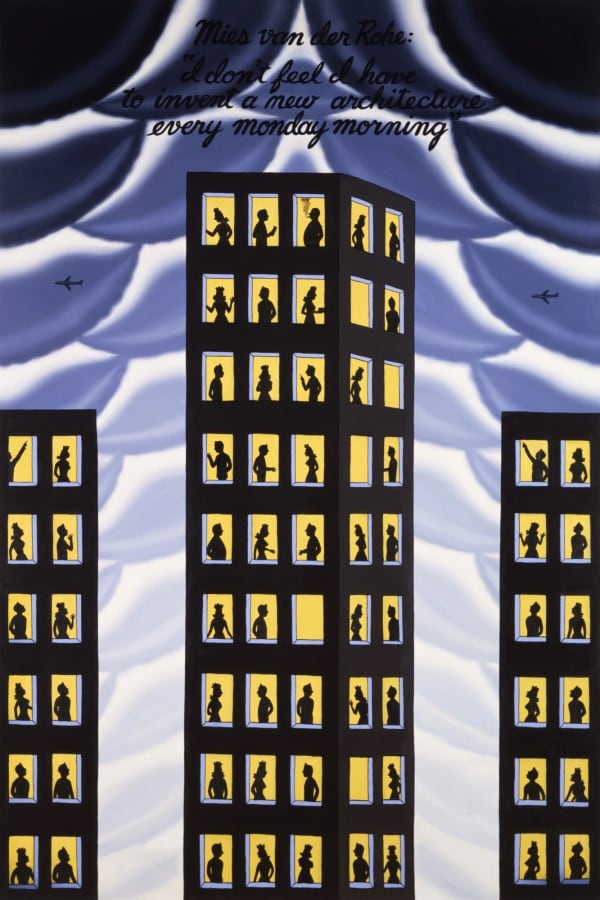
Roger Brown and Miesian Metropolitanism
Chicago Architecture Center August 23, 2022Midcentury art and architecture are too often studied separately. In the case of Roger Brown and Ludwig Mies van der Rohe, the cultural influences and...Read more -

Historic Artists' Homes & Studios: Roger Brown Study Collection
July 22, 2021Read more -

Roger Brown Study Collection In VR
September 12, 2020Read more -

Roger Brown, Hyperframe
Exhibition Video March 28, 2020Read more -

"Roger Brown" - American Art Forum with Richard Love 1987
September 14, 2019Read more -
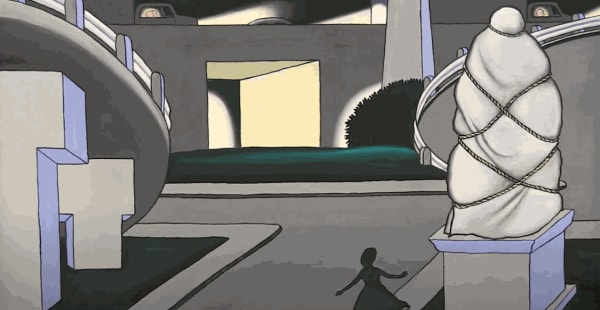
How Chicago! Imagists 1960s & 70s
June 26, 2019Read more -
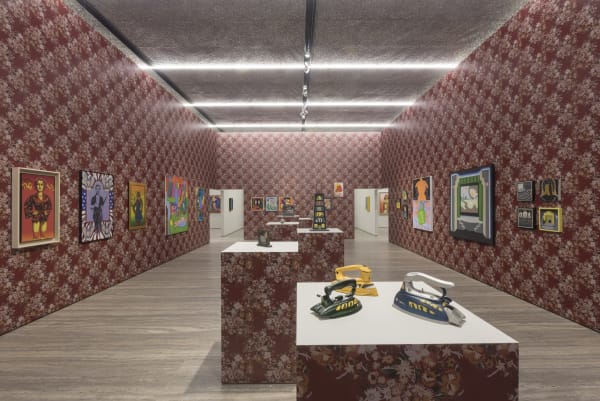
FAMOUS ARTISTS FROM CHICAGO. 1965-1975.
Foundazione Prada | Milan, Italy September 8, 2017Kavi Gupta is delighted to announce Fondazione Prada’s FAMOUS ARTISTS FROM CHICAGO. 1965-1975. The exhibition will showcase the renowned Chicago artist collective Chicago Imagist, featuring works by Roger Brown, Ed Flood, Art Green, Gladys Nilsson, Jim Nutt, Ed Paschke, Christina Ramberg, Suellen Rocca and Karl Wirsum.Read more -
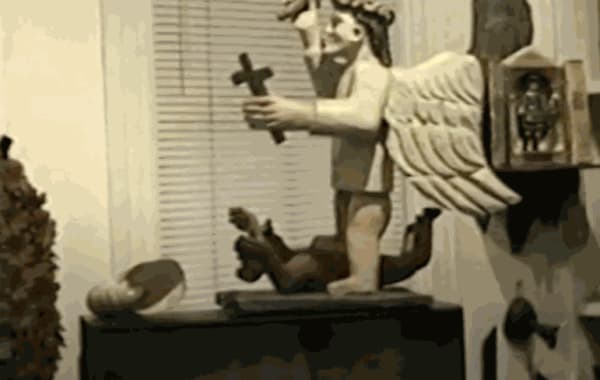
Karl Wirsum leading a tour of the Roger Brown Study Collection, April 12, 2000
May 31, 2017Read more -

Lisa Wainwright 1995 Interview with Roger Brown at his home in New Buffalo, Michigan
May 24, 2017Read more -
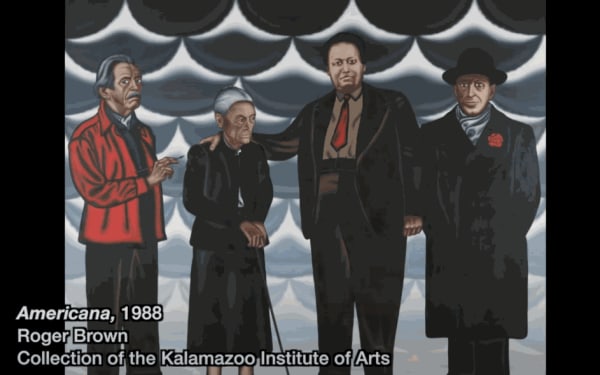
Kalamazoo Institute of Arts - Art Byte - Roger Brown
October 24, 2014Read more -
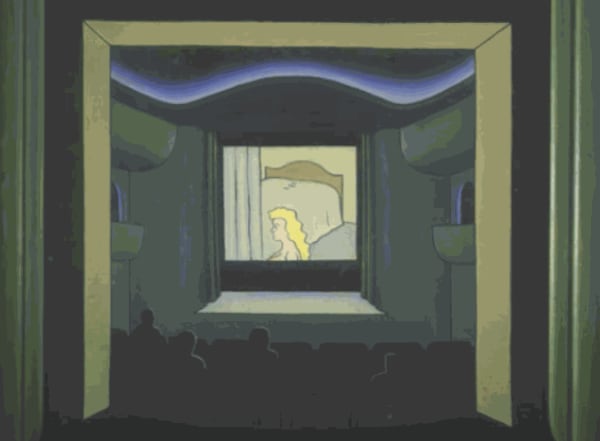
ROGER BROWN : Retrospective
May 14, 2012Read more -

Views from the Roger Brown Study Collection 1
February 23, 2009Read more
-

Kavi Gupta: Strong First-day at Expo Chicago
Justin Barbin, The Art Newspaper , April 14, 2023 -

Roger Brown: Memory Maker
Jake Brodsky , Pin-Up, December 1, 2022 -

School of the Art Institute of Chicago’s 2022 Art Auction and A Happening Auction Party
Hyperallergic, November 4, 2022 -

Today In The Culture, August 4, 2022: Roger Brown Meets Mies at Farnsworth
Ray Pride, New City, August 4, 2022 -

HOT RIGHT NOW: 10 AMERICAN POST-WAR AND CONTEMPORARY ARTISTS TO HAVE IN YOUR COLLECTION
Christies, February 20, 2020 -

REVIEW: FRIEZE? PLEASE. TRY THE UPSTART FELIX ART FAIR AT THE HOLLYWOOD ROOSEVELT
Christopher Knight, Los Angeles Times, February 20, 2020 -

The Keeper: Roger Brown, the Artist as Voracious Collector
Roberta Smith, The New York Times, August 29, 2019 -

IN CHICAGO, OVERLOOKED ACHIEVEMENTS BY L.G.B.T.Q. ARTISTS
Arthur Lubow, The New York Times, August 2, 2019 -

THE “FUNDAMENTALLY TRANSGRESSIVE” ATTITUDE OF THE CHICAGO IMAGISTS
Elephant, Elephant, March 13, 2019 -

ART REVIEW ‘3-D DOINGS: THE IMAGIST OBJECT IN CHICAGO ART, 1964-1980’ REVIEW: A CELEBRATION OF THE WEIRD (EXCERPT)
Peter Plagens, The Wall Street Journal, September 18, 2018 -

BEST OF 2017: OUR TOP 20 EXHIBITIONS ACROSS THE UNITED STATES
HYPERALLERGIC, December 21, 2017 -

ROGER BROWN – FONDAZIONE PRADA
Fondazione Prada, September 8, 2017 -

Grappling with Authorship and Acceptance in the Pop Art of Roger Brown
Sarah Rose Shap, HYPERALLERGIC, June 6, 2017 -

ROGER BROWN – ART AIDS AMERICA, ALPHAWOOD GALLERY
Kavi Gupta Gallery, December 8, 2016 -

Face to Face, Warhol and Brown Reveal Deeper Meaning
Kerry Cardoza, NewCity ART, October 18, 2016 -

Roger Brown Goes Pop! at Kavi Gupta
Frank Mercurio, Chicago Gallery news, August 24, 2016 -

‘BONSAI’ SHOW AT MACCARONE HONORS ROGER BROWN
Roberta Smith, New York Times, July 23, 2015 -

PREPARING TO LIVE: ROGER BROWN IN CALIFORNIA
Jonathan Griffin, East of Borneo, July 21, 2015 -

GOINGS ON: ART: ROGER BROWN — MACCARONE
The New Yorker, June 26, 2015 -

CRITIC'S PICKS: NEW YORK: ROGER BROWN
Alex Javanovich, ARTFORUM, June 25, 2015 -

ROGER BROWN, 55, LEADING CHICAGO IMAGIST PAINTER, DIES
Roberta Smith, New York Times, November 26, 1997 -

Mark Price talks with Roger Brown about his sculpture, his background, and his influences.
Mark Price, Sculpture Magazine, September 1, 1997
-
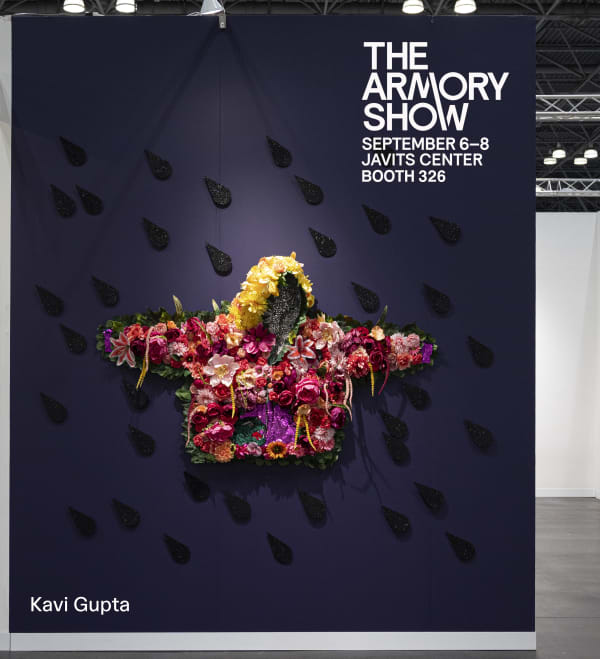
The Armory Show 2024
6 - 8 Sep 2024Booth 326 JAVITS CENTER 429 11TH AVENUE, NEW YORK, NY 10001 VIP Preview: Thursday, September 5 | 11 - 7 PM Friday, September 6 |...Read more -
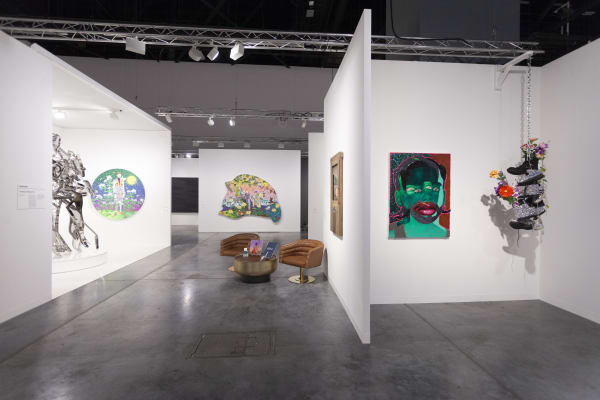
Art Basel Miami Beach 2022
29 Nov - 3 Dec 2022Kavi Gupta's presentation at Art Basel Miami Beach 2022 continues our mission to amplify the voices of diverse and underrepresented artists by spotlighting new works...Read more -

The Armory Show 2022
8 - 11 Sep 2022VIP PREVIEW Thursday, September 8 | 12–8 PM PUBLIC DATES Friday, September 9 | 12–8 PM Saturday, September 10 | 12–7 PM Sunday, September 11...Read more -

EXPO Chicago 2022
7 - 10 Apr 2022It is with great excitement that Kavi Gupta celebrates the return of EXPO Chicago. After almost three years, we are once again able to spotlight...Read more -

Art Basel Miami Beach 2021
2 - 4 Dec 2021For Art Basel Miami Beach 2021, Kavi Gupta presents an array of timely and important works by all of the artists represented in our diverse...Read more -
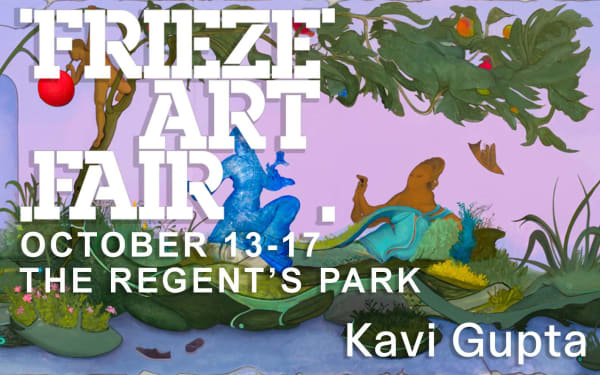
Frieze Masters 2021
13 - 17 Oct 2021Kavi Gupta is proud to be participating in the 2021 editions of both Frieze London and Frieze Masters. For Frieze London, we will present a...Read more -

Frieze London 2020
9 - 16 Oct 2020FRIEZE LONDON ONLINE 2020 Kavi Gupta is proud to be part of Frieze London’s 2020 online viewing room. Innovative platforms like this offer us ways...Read more -
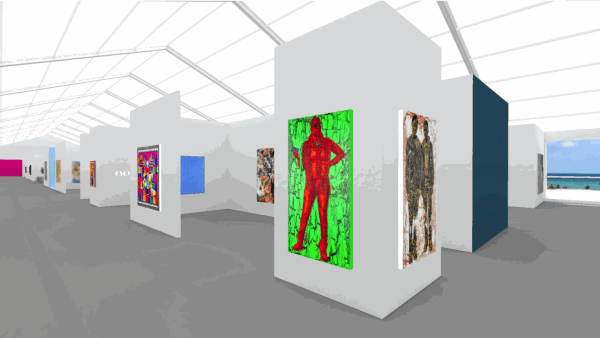
UNTITLED ART Online 2020
30 Jul - 9 Aug 2020Kavi Gupta is proud to be a participating partner in UNTITLED, ART Online, the world's first VR art fair. Utilizing groundbreaking technology in unprecedented times,...Read more -

Art Basel Miami Beach 2019
4 - 8 Dec 2019Read more -
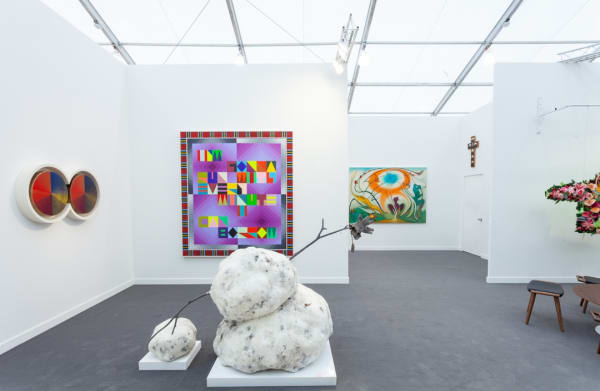
Frieze New York 2019
14 - 17 Feb 2019Kavi Gupta is pleased to participate in Frieze New York. Kavi Gupta Gallery will be located at Booth B22. For more information please contact 312-432-0708.Read more -

Art Basel Miami Beach 2018
6 - 9 Dec 20182018 has been a landmark year for AFRICOBRA (African Commune of Bad Relevant Artists), which was founded in Chicago in 1968 and defined the aesthetic...Read more -
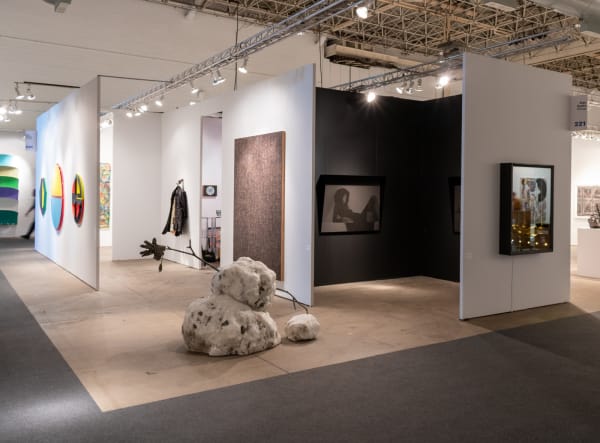
EXPO Chicago 2017
13 - 17 Sep 2017Read more -

EXPO Chicago 2016
22 - 25 Sep 2016For Expo Chicago 2016, Kavi Gupta presents a booth with a heavy emphasis on new and never-before-seen works. Coinciding with the Expo Chicago fair, Kavi...Read more
-
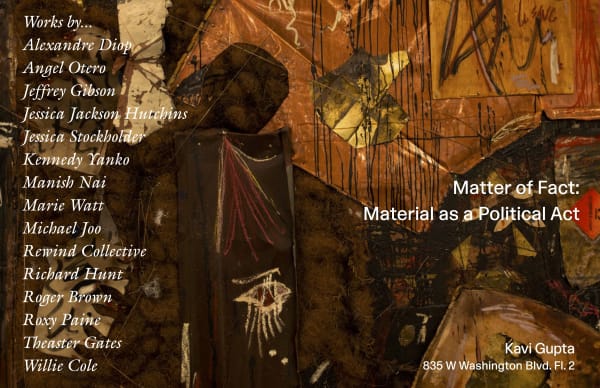
Opening Reception: Matter of Fact: Material as a Political Act
KAVI GUPTA | WASHINGTON BLVD. FL.2 25 Apr 2025Join us for the opening reception of Matter of Fact: Material as a Political Act featuring director-led tours and refreshments to celebrate the opening of...Read more -

Art Collaboration Kyoto 2022 | With KOTARO NUKAGA
Kyoto, Japan 18 - 20 Nov 2022VIP PREVIEW Thursday, November 17 OPENING HOURS Friday, November 18 | 12 PM–7 PM Saturday, November 19 | 12 PM–7 PM Sunday, November 20 |...Read more -

ROGER BROWN AND MIESIAN METROPOLITANISM
Chicago Architecture Center, Chicago, IL 11 Aug 2022Midcentury art and architecture are too often studied separately. In the case of Roger Brown and Ludwig Mies van der Rohe, the cultural influences and...Read more -
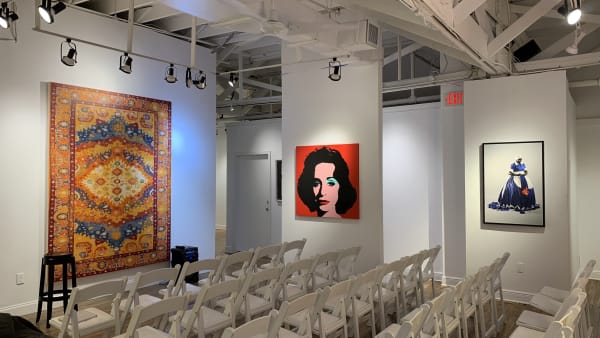
Kavi Gupta Pop-Up Exhibition in Palm Beach
Part of the Arts & Conversations Series 7 - 21 Dec 2021Presenting a Kavi Gupta Pop-Up Exhibition in Palm Beach December 7 – December 27, 2021 1608 S Dixie Highway, West Palm Beach Register for appointments...Read more
-
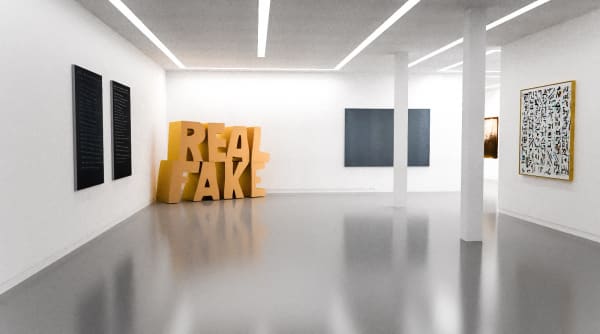
THE WRITTEN WORD ONLINE EXHIBITION OPENS
04.24.2020The Written Word is an online exhibition examining the visual value of the verbal.Read more -

THE FIGURE IN SOLITUDE OPENS ONLINE
04.22.2020Kavi Gupta presents The Figure in Solitude, an online exhibition examining oneness.Read more -
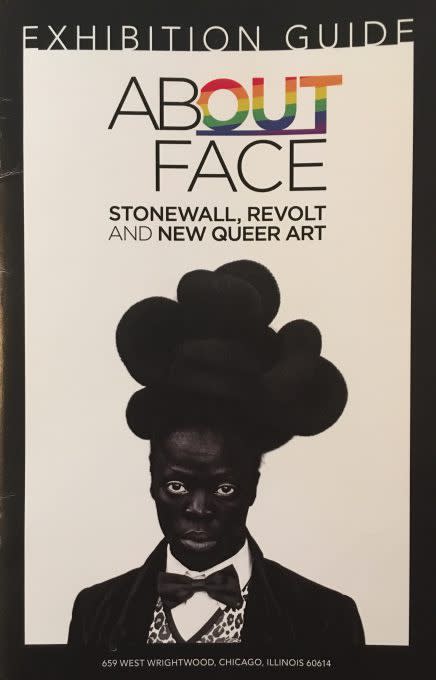
ROGER BROWN AND NICK CAVE AT WRIGHTWOOD 659
05.30.2019We had the pleasure last week of attending the VIP premier of the exhibition About Face: Stonewall, Revolt and New Queer Art at Wrightwood 659. We were enthralled by the artist symposium that kicked off the night, which included captivating talks by Carl Pope, Harmony Hammond, María Elena González, Del LaGrace Volcano, Keijaun Thomas, Sophia Wallace, and Leonard Suryajaya.Read more -
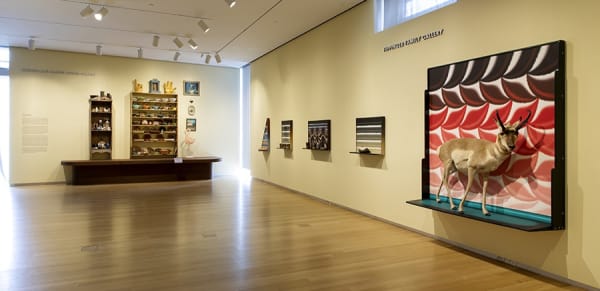
ROGER BROWN AT MAD
05.22.2019On May 2 2019, the Museum of Art and Design in New York opened Roger Brown: Virtual Still Lifes. The exhibition “brings together, for the first time, a vast grouping of the artist’s “Virtual Still Life” paintings (1995–97) made near the end of his career.Read more -
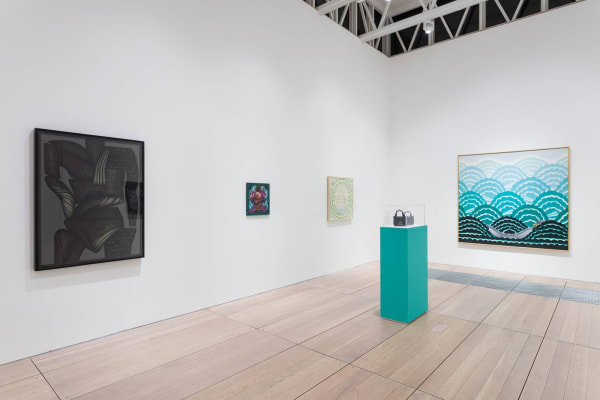
ROGER BROWN AND THE CHICAGO IMAGISTS TAKE LONDON
04.18.2019Roger Brown included in HOW Chicago! at the Goldsmith's CCA gallery LondonRead more




